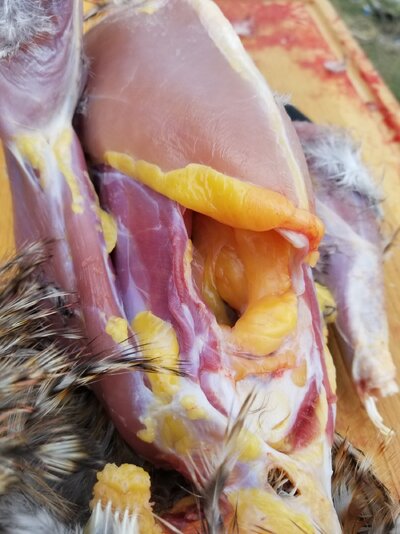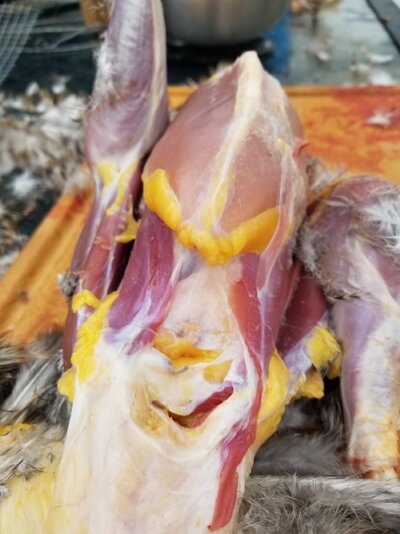Bobmc914
Chirping
I processed my least favorite of my bielefelder roosters today. I had too many; I wanted two, had to order 3, and was sent four by mistake. He was around 11 months. Anyway, it went ok, thankfully the killing went well, that was a big relief.
The kids all wanted to watch, but they had mixed reactions when it actually happened. My 9 year old daughter ran off saying, "I can't watch; this is already a nightmare." Her two younger brothers watched mostly quietly. The 3 year old said, "Mr. Scarlett is dead. He's bleeding."
I do have a question about the carcass. I found more fat than I expected, but I don't know how unusual the amount is. The keel seems rather prominent, so I was surprised to find a big hunk of fat in him. Is this unusual, or fairly typical? I have only ever dealt with supermarket chickens, so I know I don't know what is normal for a backyard dual purpose chicken. I checked the other three (same age) tonight and they feel fairly similar across the keel and breast.
They have free access to flock raiser pellets, and a couple acres of backyard and woods. The whole flock of 25 gets a few cups of kitchen scraps most days.
He was 6.1 lbs, and came out to 3.75 gutted and skinned including about 3 oz of fat I cut out and saved.
The kids all wanted to watch, but they had mixed reactions when it actually happened. My 9 year old daughter ran off saying, "I can't watch; this is already a nightmare." Her two younger brothers watched mostly quietly. The 3 year old said, "Mr. Scarlett is dead. He's bleeding."
I do have a question about the carcass. I found more fat than I expected, but I don't know how unusual the amount is. The keel seems rather prominent, so I was surprised to find a big hunk of fat in him. Is this unusual, or fairly typical? I have only ever dealt with supermarket chickens, so I know I don't know what is normal for a backyard dual purpose chicken. I checked the other three (same age) tonight and they feel fairly similar across the keel and breast.
They have free access to flock raiser pellets, and a couple acres of backyard and woods. The whole flock of 25 gets a few cups of kitchen scraps most days.
He was 6.1 lbs, and came out to 3.75 gutted and skinned including about 3 oz of fat I cut out and saved.






